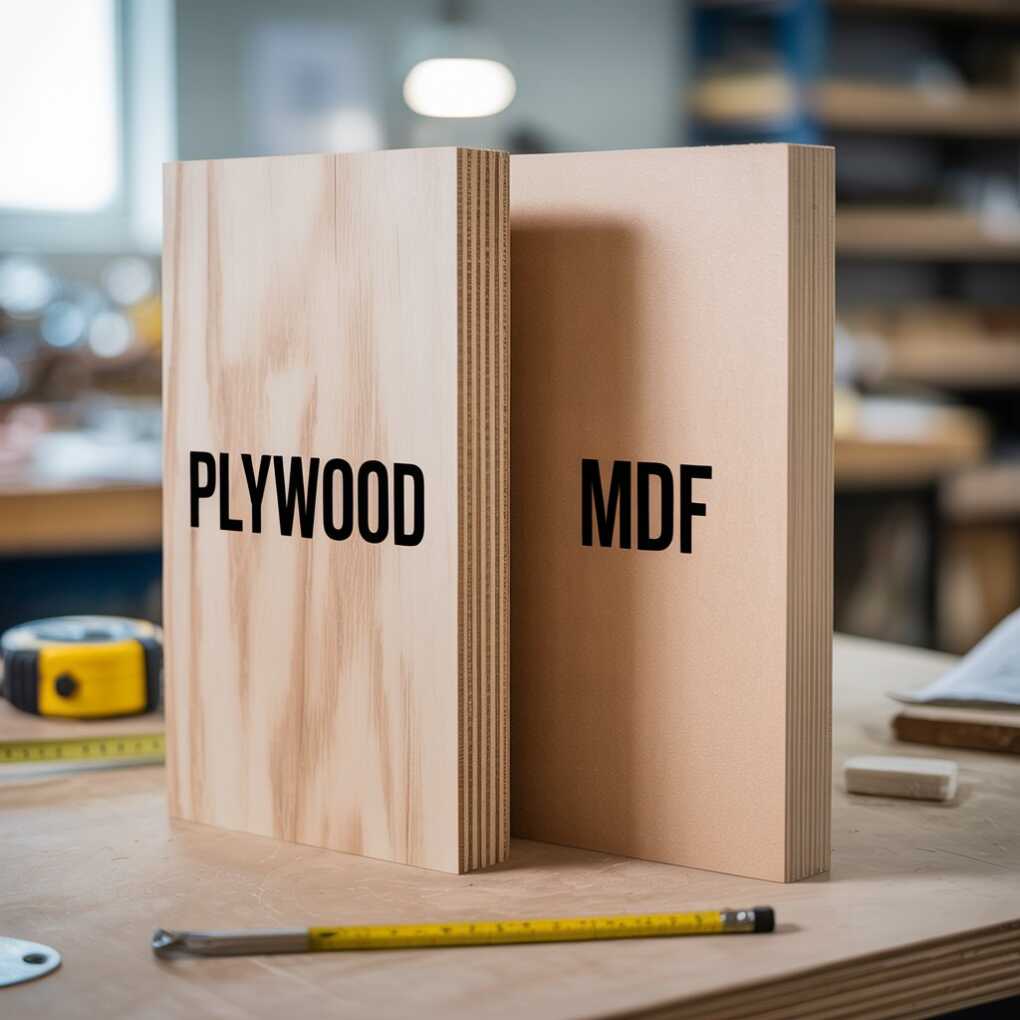When you walk into any hardware store for your next DIY project, you’re faced with a wall of wood products. Two of the most common and versatile options are plywood and Medium-Density Fiberboard (MDF). They might look similar at a glance, but these engineered woods have key differences in construction, performance, and cost. Choosing the right one can be the difference between a project that lasts a lifetime and one that disappoints. So, let’s break down the Plywood vs. MDF debate to help you make the best choice for your needs.

What is Plywood?
Plywood is a powerhouse in the world of engineered wood. It’s made by gluing together multiple thin layers, or “plies,” of wood veneer. The crucial detail is that the grain of each layer is rotated 90 degrees relative to the layer before it. This cross-graining technique is what gives plywood its impressive strength and stability.
Pros of Plywood
- Superior Strength and Durability: The cross-grain construction distributes weight effectively, making it very strong and resistant to bending or breaking under pressure. It’s an excellent structural material.
- Water Resistance: While not waterproof, higher grades of plywood (like marine-grade) use water-resistant glues that hold up well to moisture, making it suitable for kitchens, bathrooms, and even outdoor applications.
- Holds Screws Well: The layered wood grain provides a strong anchor for screws and nails, reducing the risk of them stripping or pulling out.
- Lighter Weight: Compared to MDF of the same thickness, plywood is generally lighter, making it easier to handle for large projects like building cabinets or furniture.
Cons of Plywood
- Higher Cost: Quality plywood is almost always more expensive than MDF.
- Imperfect Edges: The layered edges can have voids and are prone to splintering. They need to be finished with veneer tape, edge banding, or filler for a smooth look.
- Inconsistent Surface: The surface of plywood is real wood veneer, which means it can have knots and an uneven grain, making it more challenging to achieve a perfectly smooth painted finish.
What is MDF?
Medium-Density Fiberboard (MDF) is a different kind of engineered wood. It’s created by breaking down hardwood and softwood residuals into fine wood fibers, mixing them with wax and a resin binder, and forming them into panels by applying high temperature and pressure. The result is a dense, uniform, and very smooth board.
Pros of MDF
- Very Smooth Surface: MDF’s biggest advantage is its flawlessly smooth surface. It has no wood grain or knots, making it the perfect substrate for a glass-smooth painted or laminated finish.
- Cost-Effective: MDF is significantly cheaper than plywood, which can lead to big savings on large projects.
- Easy to Cut and Machine: Its uniform density means MDF sheets can be cut and routed to create intricate details and decorative edges without splintering or chipping.
- Consistent and Dense: Every sheet is uniform, with no voids or weak spots.
Cons of MDF
- Not Water-Resistant: MDF acts like a sponge when it comes to water. If it gets wet, it will swell, warp, and fall apart. It should never be used in areas with high moisture or outdoors.
- Very Heavy: MDF is considerably heavier and denser than plywood, which can make it difficult to work with, especially for wall-mounted cabinets or large shelves.
- Doesn’t Hold Screws Well: The fine fibers don’t provide as much grip for screws, especially on the edges. They can strip out easily if not drilled with a pilot hole.
- Creates Fine Dust: Cutting MDF produces a cloud of fine dust that can be a respiratory irritant. A good quality mask is essential when working with it.
Head-to-Head Comparison
| Feature | Plywood | MDF |
| Strength | Very strong, excellent for structural use. | Weaker, can sag under its own weight over long spans. |
| Water Resistance | Good, especially exterior or marine grades. | Very poor, swells and disintegrates when wet. |
| Surface Finish | Real wood grain, better for staining. | Perfectly smooth, ideal for painting. |
| Cost | More expensive. | More affordable. |
| Weight | Lighter. | Heavier and denser. |
| Edge Finishing | Requires edge banding or filling for a smooth look. | Edges are smooth and can be easily routed and painted. |
When to Use Plywood vs. When to Use MDF
Choosing the right material ultimately comes down to your project’s specific needs.
Choose Plywood for:
- Kitchen and Bathroom Cabinets: Its water resistance and strength are ideal for the cabinet boxes.
- Shelving: Especially for long spans or heavy items like books, as it’s less likely to sag.
- Subflooring: It provides a strong, stable base for flooring materials.
- Furniture Building: Great for the structural components of desks, tables, and bed frames.
- Projects You Want to Stain: The natural wood grain of plywood is beautiful when stained.
Choose MDF for:
- Decorative Projects: Perfect for things like wainscoting, decorative trim, and door casings where its smooth surface and machinability shine.
- Cabinet Doors: Its stability and smooth surface make it the industry standard for painted cabinet doors.
- Painted Furniture: If you’re planning a high-gloss painted finish on a piece of furniture, MDF will give you a superior result.
- Speaker Boxes: Its density is great for dampening sound and vibration.
The Final Verdict
There’s no single winner in the Plywood vs. MDF showdown. They are both excellent materials designed for different purposes. The best choice depends entirely on your project’s budget, its end-use, and the finish you desire.
For anything requiring structural strength, screw-holding power, or moisture resistance, plywood is the undisputed champion. For projects that will be painted and demand a perfectly smooth finish or intricate details, MDF is the more affordable and practical choice. By understanding the strengths and weaknesses of each, you can confidently select the right material to ensure your next home project is a success.
